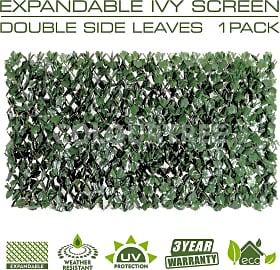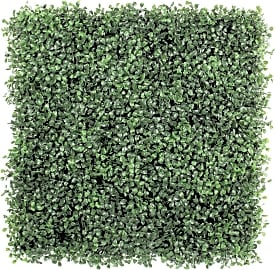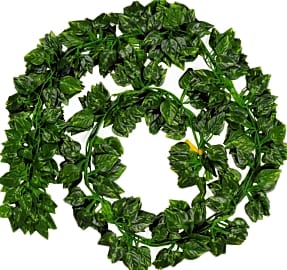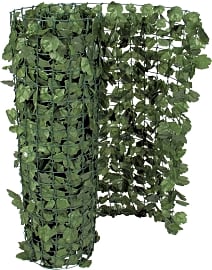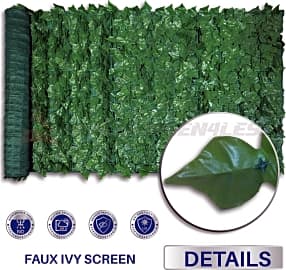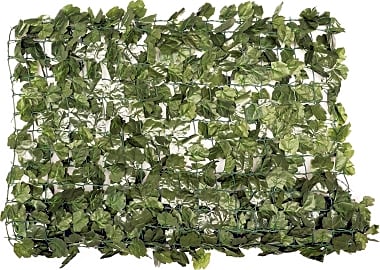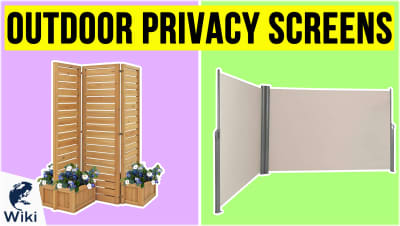The 7 Best Faux Ivy Privacy Fences

This wiki has been updated 35 times since it was first published in December of 2016. There's no need to wait around for natural hedges or other plants to grow in order to obtain privacy in your backyard. These faux ivy fences provide a verdant screen of artificial vegetation in a matter of minutes, with no time-consuming and difficult planting, watering, or pruning required. Our selection includes a variety of coverage options, from fully blocking to a more open, airy feel. When users buy our independently chosen editorial choices, we may earn commissions to help fund the Wiki.
Editor's Notes
September 02, 2020:
We know that homes and apartments vary, so we've kept a range of options, including those in different sizes, to suit various outdoor spaces. Because it pairs mesh with adequate foliage, the Tang Sunshades Depot Decoration Panel remains a workable choice for many. Like most, it doesn't come with any zip ties for installation, but they are offered for separate purchase. This isn't true of the Uland DIY, however, which do come with some cable ties. This model might take you longer to install, however, because a package consists of 20-inch by 20-inch squares. But you can cut them to create other sizes and shapes, so it's a useful choice when you need versatility.
We also kept two choices that aren't as lush and full as some others, the EZ-Ivy Dramatic Danica and the Best Choice Products Screen. If you're hoping for 100 percent coverage that completely stops prying eyes, these may prove disappointing. On the other hand, if you just want to spruce up a chain link or garden fence, they might do the trick. They're easy to install, too.
July 04, 2019:
At this time, the Compass Home Expandable has become tough to find, so we opted to remove it. If you're looking for a similar trellis, you might consider the ColourTree model instead, which reaches nearly 10 feet in length when opened fully. Its leaves are treated to be UV-resistant, so they can handle harsh sunlight. If you'd rather have a mesh backing, the Tang Sunshades Depot Decoration Panel is currently the one to beat. It's also UV-resistant, and it comes in plenty of sizes, so coverage shouldn't be an issue.
For anyone who needs more customization options, there's the Unilove Charisma and the ColourTree DIY. These are great for covering your fences but also for craft projects and indoor uses, so you get a lot of bang for your buck. They aren't fences per se, however, so if you want something you can install in a hurry, they might not be the best option.
Special Honors
FenceScreen NatraHedge Trellis The FenceScreen NatraHedge Trellis boasts silk ivy leaves, so they don't have the shiny, fake look of some low-quality plastic choices. Each expandable fence arrives with fasteners, so installation is a breeze, whether you choose to place the trellis vertically or horizontally. fencescreen.com
Commercial Silk English Ivy Because the Commercial Silk English Ivy screens can be manufactured to your specifications, you won't have to worry at all about sizing — although this makes them something of an investment, as you might imagine. They're made with top-notch weather-resistant materials, however, so you can rely on these screens in the long run. commercialsilk.com
Mother Nature, Man-Made
They come in all shapes and sizes, from individual strips to full panels, and installation is straightforward.
If you've got nosy neighbors or live in a cramped urban area that makes you crave a quiet, green space for contemplation, a faux ivy privacy screen can provide you with the solitude you desire. They come in all shapes and sizes, from individual strips to full panels, and installation is straightforward. If you know what to look for, you can easily select a long-lasting design that looks extremely close to actual vegetation.
A high-quality fence may have tear-proof polyester leaves with embossed detailing, plus the five-point shape that’s characteristic of genuine ivy. This fabric construction gives them a delicate, fluttery look and feels similar to the real thing when you touch it. Some screens may use plastic instead, which can effectively mimic the glossy appearance certain types of ivy have, but it won't look very appealing if it's manufactured with inferior material. Opt for dense designs that are strongly secured to their backing, which should be made of tough, all-weather plastic or bendable wire. Some producers take things a step further and make their leaves adjustable, enabling you to rotate them to get the exact coverage you want.
You’ll need your faux foliage to be UV-tested and fade-resistant, so it can endure long sunny days without losing its vibrancy. There are plenty of options out there that have mesh backing, which not only provides additional protection from aging but also adds another layer of privacy, since peeping toms won’t be able to peer through. These reinforced models can do double duty as windscreens, too, so you don’t have to deal with goosebump-inducing breezes when you’re trying to sunbathe.
In a perfect world, your privacy screen will come bundled with everything you need to install it, which shouldn’t be much. Most will simply adhere to your existing wood or metal fence via zip ties or twine, and should have small locking clasps to secure to each other in the event that you purchase multiple panels. For a brick or concrete wall, you may have to get a little creative and drill a few holes for hooks.
Why Go Faux?
There are myriad reasons to get an imitation ivy barrier instead of growing your own. One of the most compelling justifications is time. We’re not all made of it, and obtaining a faux fence means that you can have a nature-infused space in minutes. Ivy grows fast, but it still takes months to become fully established, and that’s not accounting for the process of planting it and all the time thereafter that you’ll spend maintaining it. It needs to be properly trained and is notoriously laborious to contain, so you’ll need to keep a wary eye on it. When you’ve got a million other things to take care of, the idea of installing a fence in a few minutes is pretty dang appealing.
There's no need to water a faux alternative or add any noxious toxins to it, so you'll be conserving precious H2O and keeping chemicals out of the picture if you choose one.
It also saves you money. If you're planting genuine climbing vines, you'll need to fertilize and prune them, remove threatening weeds, and apply pesticides. Plant food and gardening tools aren't free, so you'd have to anticipate some start-up costs right off the bat. There's no need to water a faux alternative or add any noxious toxins to it, so you'll be conserving precious H2O and keeping chemicals out of the picture if you choose one.
Another convenience is that a faux fence will thrive in every season and climate, rain or shine. No placement strategy is necessary, and you won't need to cover it to protect it from frost. It also won't attract insects, flies or mites, or require consistent cutting in order to be kept under control. Your imitation plant will never die, and won't produce unattractive discolored leaves.
Something else to note is that certain types of ivy are mildly poisonous and can irritate bare skin. English ivy, for example, contains a substance known as falcarinol. When touched, it can cause dermatitis, a condition in which the skin becomes inflamed and itchy. It can also be toxic for dogs, cats, and even horses when eaten in substantial quantities, so if you have pets, kids, or active wildlife around, it may be best to avoid it altogether.
A Very Brief History Of Privacy
For most of history, privacy has been a secondary concern for people. Early tribal civilizations valued community and saw solitude as rude or unhealthy, not to mention inefficient for hunting and gathering purposes. The ancient Greeks treasured their personal space somewhat more, using their knowledge of geometry to build their homes in such a way so as to let natural light in without exposing the interior of the house. Affluent Romans were willing to sacrifice seclusion in order to show off their immense wealth by opening their expansive gardens and elaborate abodes to the public. The lower classes, however, were generally packed into crowded apartments with paper thin walls, so there was no escaping the goings-on of the neighbors.
It wasn’t uncommon for couples to get intimate regardless of who was in the room.
During the Middle Ages, beds were an expensive luxury, and many families lacked the funds to obtain more than one. This meant that parents, children, servants, guests, and whoever else was around would spend the night together. It wasn’t uncommon for couples to get intimate regardless of who was in the room.
The advent of Gutenberg’s printing press meant that fortunate Europeans could obtain their own books and study by themselves if they desired, yet public readings remained popular until the 1800s. The wealth that came along with the Industrial Revolution made life a bit more exclusive for people of means, but the poor were still cramped into one-room apartments in crowded slums. Interestingly enough, few people actually lamented their lack of privacy; it simply seemed illogical to want any. These days, the idea of being left alone is built into our lives, with innocuous things like bedrooms and headphones surreptitiously shaping our expectations about what we believe to be a fundamental right.


